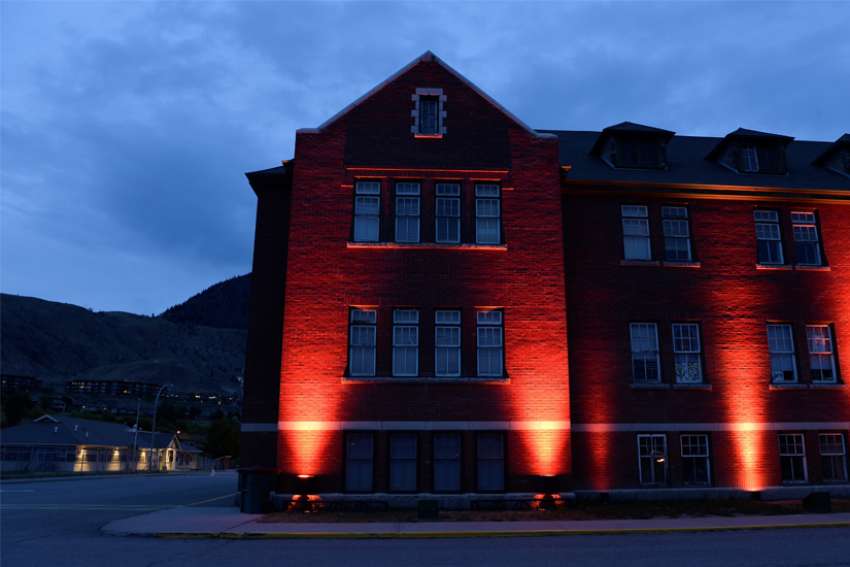On the third anniversary of Casimir saying a ground-penetrating radar scan resulted in “the confirmation of the remains of 215 children,” she made the distinct change that the findings were "215 anomalies."
Casimir said the Tk’emlúps te Secwépemc researchers are immersed in their multi-disciplinary investigation, employing “archival and documentary research and analysis, Wenecwtsínem (truth telling) with KIRS survivors, archaeological and anthropological surveys and studies, and potential DNA and other forensic methods.”
All of the findings to date and the step-by-step process is currently being kept confidential to “preserve the integrity of the investigation,” said Casimir. She added “our investigators' findings to date are consistent with the presence of unmarked burials.”
Casimir was speaking at a news conference June 26 that centred on the Sacred Covenant that Tk’emlups te Secwepemc signed with the Archdiocese of Vancouver and Diocese of Kamloops on Easter Sunday. She explained the reasoning behind the shift in language, saying this decision was informed by how GPR specialist Dr. Sarah Beaulieu identified her findings and by history.
“In according to what was presented at the Coast Canadian Inn when we had Dr. Sarah,” said Casimir, “she also confirmed the anomalies. But it was also the historical details and oral histories that also spoke truth to the potential gravesites of the children that did not go home. It was those truths, and they were always kind of identified as anomalies, but also identified as the children who did not go home.
“We know that truth among our survivors, and that is what brings us to today with that truth-finding, but also to the investigation and these meaningful steps to seek answers.”
The Sacred Covenant between the Catholic dioceses and the First Nation was first unveiled in English and Chinook for public viewing on June 21, National Indigenous Peoples Day. There is recognition in the document that “developing a strategy to address unmarked graves is complicated and will require long-term thoughtful discussion about the most appropriate procedures to document, commemorate and protect those burials.” The two B.C. dioceses — referred to jointly throughout the covenant as the “Catholic Parties” — pledged to support these efforts.
No matter what future investigative findings arise, a shared truth that Vancouver Archbishop Michael Miller and Bishop Joseph Nguyen of Kamloops agreed to is the “Indian residential school system did great harm” to Tk’emlúps te Secwépemc and other Indigenous communities who sent children to the former KIRS. Paragraph 29 of the document states: “separating children from their families without considering individual circumstances violates Catholic social teaching.”
Miller lamented the pain caused by residential schools
“The residential school system did do great damage to the languages, traditions in this community and we see the ongoing impact of that today,” said Miller. “The Church was wrong — wrong — in how it complied in implementing a government colonist policy that resulted in the separation of children from their parents and their families. Even the most ardent skeptics must know that a system requiring or pressuring the separation of families would have devastating consequences — tragic consequences.”
Though the Sacred Covenant said such cases were overshadowed by the negativity, one of the realities accepted by all signatories is that some “former students have spoken positively about their experience at the Kamloops Indian Residential School.”
Casimir and Miller both identified the commitments to actions' section as the true heart of the Sacred Covenant. The major efforts to be undertaken going forward include:
· Seeking honourable ways to memorialize the children of residential schools;
· Working together in transparency to determine the truth: “the identities of the children, the circumstances of their deaths and all information about the missing children to ensure we can accurately determine their home communities so they can rest in peace and their families have answers”;
· The Catholic Parties pledge to provide mental health support and family counselling for loved ones and others who may be buried on the former KIRS grounds;
· That the dioceses arm Tk'emlúps te Secwépemc First Nation with expertise and technical services to help answer questions raised by previous GPR work;
· Dioceses support fundraising for First Nations who seek to maintain their former residential schools as national monuments.
Read the entire Sacred Covenant at https://www.catholicregister.org/item/36895-archdiocese-of-vancouver-and-kamloops-first-nation-release-sacred-covenant-on-indigenous-peoples-day


